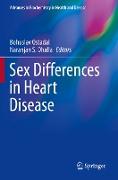- Start
- Sex Differences in Heart Disease
Sex Differences in Heart Disease
Angebote / Angebote:
Cardiovascular diseases are the leading cause of mortality in men and women. Unfortunately, women have traditionally been excluded from clinical trials, and female animals have been used less or sex was not reported in basic research studies. Until recently, consideration of both sexes was not required in clinical and preclinical studies focusing on cardiovascular diseases. However, the number of clinical and experimental papers dealing with sex differences and heart disease significantly increases during the last years. This trend is obviously the result of at least two facts: the number of examples of different behavior of the male and female heart under physiological and pathological conditions is steadily increasing and there were controversial reports on the beneficial and adverse effect of hormonal replacement therapy. Detailed molecular and cellular mechanisms of these differences are still unknown but one is clear already today: sex differences are so important that they should be considered by the selection of optimum diagnostic and therapeutic procedures in clinical practice.
The book presents 16 manuscripts on sex differences of heart disease, as developed by several investigators, the volume is organized in four parts. Part I, dealing with sex differences in cardiac ischemic injury, includes 5 chapters on experimental aspects of cardiac ischemia/reperfusion injury, the role of testosterone, and clinical aspects of ischemic heart disease. Part II is devoted to sex differences in heart failure and includes four chapters. Discussion in this part of the book is centered around the sex differences in heart failure due to volume overload. Part III of this volume includes four papers on risk factors of cardiovascular diseases, namely hypertension and obesity, and, finally, three chapters in part IV deal with sex differences of cardiac mitochondria under different pathological conditions. We believe this book will be very useful for cardiovascular scientists, graduate students, postdoctoral fellows and other health professionals.
Folgt in ca. 5 Arbeitstagen
